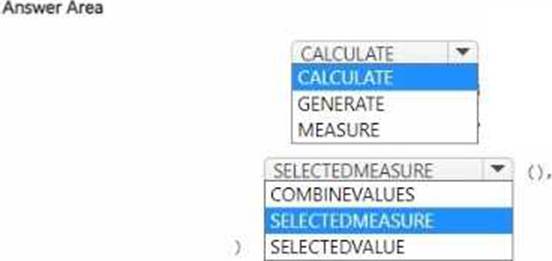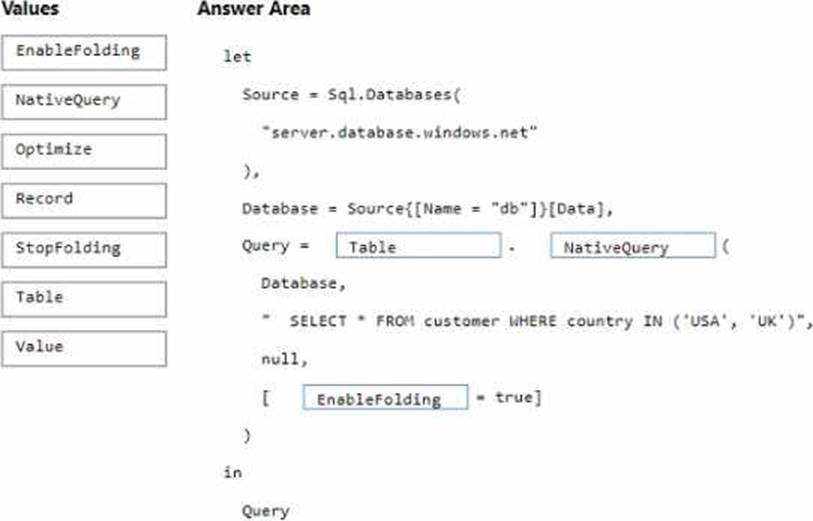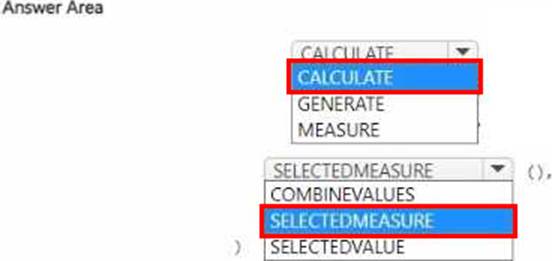Microsoft DP-600 Übungsprüfungen
Zuletzt aktualisiert am 26.04.2025- Prüfungscode: DP-600
- Prüfungsname: Microsoft Fabric Analytics Engineer
- Zertifizierungsanbieter: Microsoft
- Zuletzt aktualisiert am: 26.04.2025
DRAG DROP
You are creating a dataflow in Fabric to ingest data from an Azure SQL database by using a T-SQL statement.
You need to ensure that any foldable Power Query transformation steps are processed by the Microsoft SQL Server engine.
How should you complete the code? To answer, drag the appropriate values to the correct targets. Each value may be used once, more than once, or not at all. You may need to drag the split bar between panes or scroll to view content. NOTE: Each correct selection is worth one point.
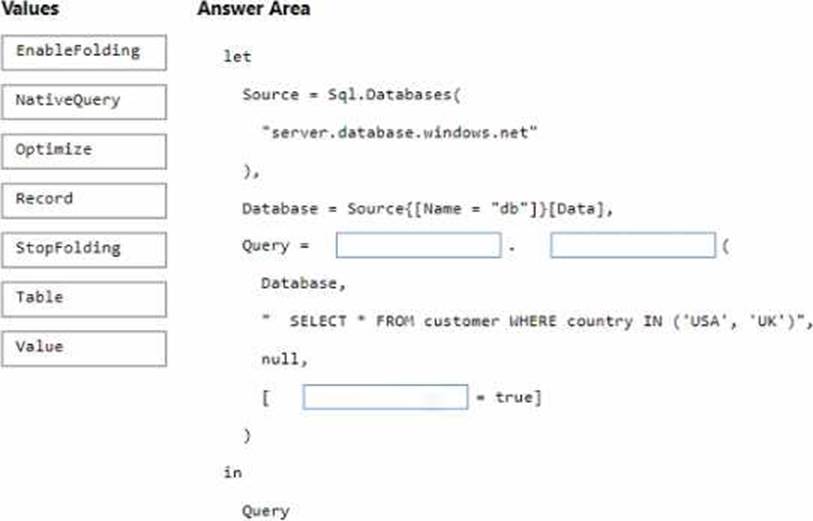
You need to recommend a solution to prepare the tenant for the PoC.
Which two actions should you recommend performing from the Fabric Admin portal? Each correct answer presents part of the solution. NOTE: Each correct answer is worth one point.
- A . Enable the Users can try Microsoft Fabric paid features option for specific security groups.
- B . Enable the Allow Azure Active Directory guest users to access Microsoft Fabric option for specific security groups.
- C . Enable the Users can create Fabric items option and exclude specific security groups.
- D . Enable the Users can try Microsoft Fabric paid features option for the entire organization.
- E . Enable the Users can create Fabric items option for specific security groups.
Note: This question is part of a series of questions that present the same scenario. Each question in the series contains a unique solution that might meet the stated goals. Some question sets might have more than one correct solution, while others might not have a correct solution.
After you answer a question in this section, you will NOT be able to return to it. As a result, these questions will not appear in the review screen.
You have a Fabric tenant that contains a semantic model named Model1.
You discover that the following query performs slowly against Model1.

You need to reduce the execution time of the query.
Solution: You replace line 4 by using the following code:
![]()
Does this meet the goal?
- A . Yes
- B . No
You have a Fabric tenant that contains a warehouse.
A user discovers that a report that usually takes two minutes to render has been running for 45 minutes and has still not rendered.
You need to identify what is preventing the report query from completing.
Which dynamic management view (DMV) should you use?
- A . sys.dm-exec_requests
- B . sys.dn_.exec._sessions
- C . sys.dm._exec._connections
- D . sys.dm_pdw_exec_requests
You have a Fabric tenant that contains customer churn data stored as Parquet files in OneLake. The data contains details about customer demographics and product usage.
You create a Fabric notebook to read the data into a Spark DataFrame. You then create column charts in the notebook that show the distribution of retained customers as compared to lost customers based on geography, the number of products purchased, age. and customer tenure.
Which type of analytics are you performing?
- A . prescriptive
- B . diagnostic
- C . descriptive
- D . predictive
You have a Fabric tenant that contains a lakehouse named Lakehouse1.
You need to prevent new tables added to Lakehouse1 from being added automatically to the default semantic model of the lakehouse.
What should you configure? (5)
- A . the semantic model settings
- B . the Lakehouse1 settings
- C . the workspace settings
- D . the SQL analytics endpoint settings
You have a Fabric tenant that contains a machine learning model registered in a Fabric workspace. You need to use the model to generate predictions by using the predict function in a fabric notebook.
Which two languages can you use to perform model scoring? Each correct answer presents a complete solution. NOTE: Each correct answer is worth one point.
- A . T-SQL
- B . DAX EC.
- C . Spark SQL
- D . PySpark
You have a Fabric tenant that contains a warehouse.
Several times a day. the performance of all warehouse queries degrades. You suspect that Fabric is throttling the compute used by the warehouse.
What should you use to identify whether throttling is occurring?
- A . the Capacity settings
- B . the Monitoring hub
- C . dynamic management views (DMVs)
- D . the Microsoft Fabric Capacity Metrics app
You have a Microsoft Power Bl report named Report1 that uses a Fabric semantic model.
Users discover that Report1 renders slowly.
You open Performance analyzer and identify that a visual named Orders By Date is the slowest to render.
The duration breakdown for Orders By Date is shown in the following table.
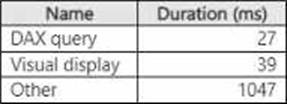
What will provide the greatest reduction in the rendering duration of Report1?
- A . Change the visual type of Orders By Dale.
- B . Enable automatic page refresh.
- C . Optimize the DAX query of Orders By Date by using DAX Studio.
- D . Reduce the number of visuals in Report1.
HOTSPOT
You have a Microsoft Power Bl semantic model.
You plan to implement calculation groups.
You need to create a calculation item that will change the context from the selected date to month-to-date (MTD).
How should you complete the DAX expression? To answer, select the appropriate options in the answer area. NOTE: Each correct selection is worth one point.
